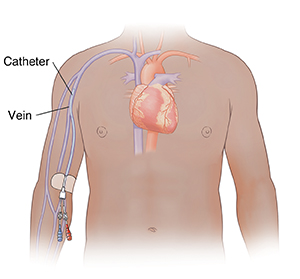A
B
C
D
E
F
G
H
I
J
K
L
M
N
O
P
Q
R
S
T
U
V
W
X
Y
Z
Back to Intro
Click a letter to see a list of medical procedures beginning with that letter.
Click 'Back to Intro' to return to the beginning of this section.
Discharge Instructions: Caring for Your Midline Catheter
You are going home with a midline catheter. This small, soft tube has been placed in a vein in your upper arm. It’s used when your healthcare provider wants you to have IV (intravenous) fluids or medicines. This treatment is to last for more than a few days.
When you have a midline catheter, you have a higher risk for infection. You must take extra care washing your hands and preventing the spread of germs. This sheet will help you remember what to do to care for your midline catheter at home.

Understand your role
You and your caregivers will be shown how to care for your midline catheter before going home. Make sure you understand what to do, how long you may need the catheter, and when to follow up with your provider.
You may be told to flush your midline catheter with a saline or heparin solution. You may also be told to change the catheter’s injection caps and bandage (dressing). Or a home care nurse may do this for you during a visit. Only do these things if you’re told to. Follow all instructions you are given. Have clean or sterile gloves on hand if you will be changing your dressing over the catheter. Know what supplies you need. Keep enough on hand to care for your catheter.
Protect the midline catheter
If the midline catheter gets damaged, it won’t work correctly and could raise your chance of infection and other problems. Call your healthcare provider right away if any damage occurs. To protect your midline catheter at home:
-
Prevent infection. Use good hand hygiene—wash your hands with soap and clean, running water for at least 20 seconds. Or use an alcohol-based hand sanitizer that contains at least 60 % alcohol. Don’t touch the catheter or dressing unless you need to. And always clean your hands before and after you come in contact with any part of the catheter. Your caregivers, family members, and any visitors should use good hand hygiene, too.
-
Keep the catheter dry. The catheter and dressing must stay dry. Don’t soak your arm in a bathtub, go swimming, use a hot tub, or do other things that could get your midline catheter wet. Take sponge baths to prevent getting your catheter wet. If your healthcare provider says it is OK to shower, ask them about the best way to keep the catheter dry. If the dressing does get wet, change it only if you have been shown how. Otherwise, call your healthcare team right away for help.
-
Don’t damage the catheter. Don’t use any sharp or pointy objects around the catheter. This includes scissors, pins, knives, razors, or anything else that could cut it or put a hole in it. Also, don’t let anything pull or rub on the catheter, such as tight sleeves on clothing.
-
Watch for signs of problems. Pay attention to how much of the catheter sticks out from your skin. If this changes, let your healthcare provider know. Also watch for cracks, leaks, or other damage in the catheter. Look for any redness, swelling, irritation, or fluid leaking where the catheter enters the skin. Be alert if you find the skin on your arm feels tight or your arm looks bigger than your other arm. And if your dressing gets dirty, loose, or wet, change it if you have been told how to do it. Or call your healthcare team right away.
Protect your arm
The arm with the midline catheter is at risk for developing blood clots. This is a serious problem. To help prevent it:
-
Use your arm with the midline catheter for normal daily activities. Not moving the arm can lead to blood clots. So it’s important to move your arm as you normally would. Your healthcare team may suggest light arm exercises.
-
Don’t do activities or exercises that require major use of your arm, such as sports or lifting heavy objects, unless your healthcare provider says it’s OK. Check with your healthcare provider about the amount of weight you can safely lift.
-
Don’t do any activities that cause mild pain in your arm. Talk with your healthcare provider if you have concerns about pain or range of motion.
-
Drink plenty of water. Staying hydrated helps keep clots from forming.
When to call your healthcare provider
Make sure you know what number to call with questions or problems, even on evenings, weekends, and holidays. Call your healthcare provider right away if you have any of the following:
-
Pain or burning in your arm, shoulder, chest, or back
-
Fever of 100.4°F (38°C) or higher, or as advised by your provider
-
Chills
-
Signs of infection at the catheter site. These include pain, redness, drainage, burning, or stinging.
-
Muscle stiffness or trouble moving
-
Bleeding at the catheter insertion site
-
Tightness in your arm, above the catheter site
-
Gurgling noises coming from the catheter
-
Breaks, cracks, leaks, or other damage in the catheter or catheter falls out
Online Medical Reviewer:
Mahammad Juber MD
Online Medical Reviewer:
Marianne Fraser MSN RN
Online Medical Reviewer:
Rita Sather RN
Date Last Reviewed:
8/1/2023
© 2000-2025 The StayWell Company, LLC. All rights reserved. This information is not intended as a substitute for professional medical care. Always follow your healthcare professional's instructions.